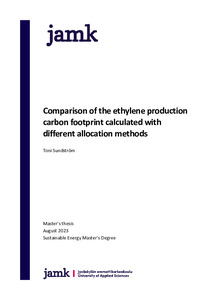Comparison of the ethylene production carbon footprint calculated with different allocation methods
Sundström, Toni (2023)
Sundström, Toni
2023
All rights reserved. This publication is copyrighted. You may download, display and print it for Your own personal use. Commercial use is prohibited.
Julkaisun pysyvä osoite on
https://urn.fi/URN:NBN:fi:amk-2023091325768
https://urn.fi/URN:NBN:fi:amk-2023091325768
Tiivistelmä
Climate change affects the lives of millions of people every day. The main driver for the climate change is the increasing amount of greenhouse gases in our atmosphere. Industry is a large greenhouse gas producer on our planet. Therefore, it is important to find new ways to reduce the amount of greenhouse gas generated by industry. One way is to use more sustainable feedstocks in industry. In many industry sectors it is not possible to switch the fossil feedstock totally to sustainable feedstock. Switching totally to bio-feedstock often requires technical changes to the process. The availability of bio-feedstock does not meet the demand of the industry either.
Petrochemical industry falls into this sector. Plastic itself is still irreplaceable for us. Although plastic is associated as visible waste because of its poor recycling, its production generates fossil-based greenhouse gases. One way to reduce fossil-based greenhouse gases is to increase the amount of bio or circular feedstocks to steam crackers. Steam crackers produce olefins which are the main building blocks when producing plastic.
The aim was to count and illustrate the emission impact of producing ethylene from fossil- and bio-based feedstocks. The study aimed to find emission factors that best represent regional ethylene production. The recommendations were used to find the right allocation methods. Through these, the emission impact for both fossil- and bio-based feedstock was counted by using emission factors for bio-feedstock, naphtha-feedstock, and for the steam cracker.
Through the research questions, variations in the carbon footprints could be demonstrated, depending on the feedstock and allocation method. The climate impacts caused by both feedstocks were allocated using different allocation methods to enable their comparison.
The results indicated that the impact of biogenic carbon dioxide removal on the product's carbon footprint is significant. Different allocation methods also demonstrated substantial variability in product carbon footprints.
In conclusion, the transparency of calculations underlying the product's carbon footprint and the emission factors used is essential. Without background information, comparing carbon footprints might not be reliable.
Petrochemical industry falls into this sector. Plastic itself is still irreplaceable for us. Although plastic is associated as visible waste because of its poor recycling, its production generates fossil-based greenhouse gases. One way to reduce fossil-based greenhouse gases is to increase the amount of bio or circular feedstocks to steam crackers. Steam crackers produce olefins which are the main building blocks when producing plastic.
The aim was to count and illustrate the emission impact of producing ethylene from fossil- and bio-based feedstocks. The study aimed to find emission factors that best represent regional ethylene production. The recommendations were used to find the right allocation methods. Through these, the emission impact for both fossil- and bio-based feedstock was counted by using emission factors for bio-feedstock, naphtha-feedstock, and for the steam cracker.
Through the research questions, variations in the carbon footprints could be demonstrated, depending on the feedstock and allocation method. The climate impacts caused by both feedstocks were allocated using different allocation methods to enable their comparison.
The results indicated that the impact of biogenic carbon dioxide removal on the product's carbon footprint is significant. Different allocation methods also demonstrated substantial variability in product carbon footprints.
In conclusion, the transparency of calculations underlying the product's carbon footprint and the emission factors used is essential. Without background information, comparing carbon footprints might not be reliable.
